|
Edged tools and saws
There are countless types and brands of knives and edged tools. I will not tell anyone what to carry in the woods or what the best knife of all is.
I don`t know what the best knife is or even if it exist.
You have to decide yourself what type and brand that suits you.
I will however write about some of the knives that I own, and my experiences with them. Maybe that will be of some help when you decide what to carry yourself.
No matter what knife you buy, just be sure it is sharp.
A dull knife (and axe) is a dangerous tool. It slips easily and you have to use much more force when carving than with a sharp knife.
I carry a red DMT diamond hone when out hunting or fishing just in case my knife need a little touch up.
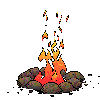 Sharpening your tools Sharpening your tools
The folding knife.
I like the swiss army knife (SAK), particularly the large ones. They are fairly cheap, durable and have most tools you will need in the woods (knife blade, saw and awl).
I have a Victorinox Forester (picture below) myself and I find it a very sturdy and good knife. With the saw one could cut down trees about 8-9 cm thich. The locking blade is also big plus (liner lock).
I now use it as a sidekick to my fixed blade when ever Iím out in the woods.
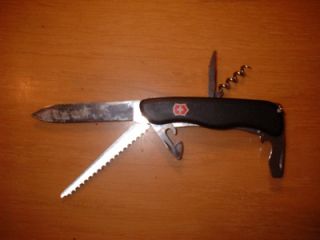
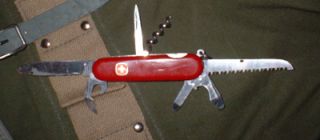 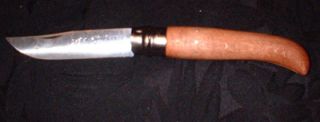
I also have a smaller one, a Wenger Hiker (above left). Iíve had it for over 25 years, and the only damage it has sustained is a cracked handle plate. This was my everyday carry for 15 years.
I highly recommend these knives.
I also own a French folding knife; an Opinel (above right). The knife is very sharp (non stainless), but itís weakly built. Not for heavy work. It is however easy to customise and very cheap.
I donít usually use folders with only one blade. I see no reason for it (I own some though).
I rather carry a fixed blade instead.
Donít baton wood with your folder, it will most likely break.
That said I`ve actually used the VIC Forester to baton firewood and no harm was done, but I do not recommend it.
Multitools.
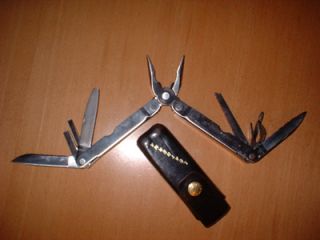 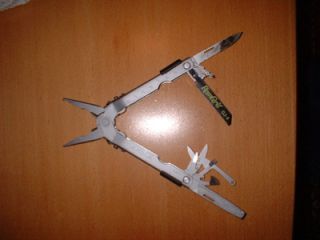
The Leatherman super tool (left). Iíve used this as an everyday carry for some years and I think itís a nice tool. The only downside Iíve found is that it is made of rather soft steel. I tried to cut a small nail with it and dented the wire cutter. I think a tool of this size should at least be able to cut a small nail.
Other than that Iím very pleased with it. It has become a little looser in its joints, but no more than I expected. All in all a nice tool that I recommend.
The Gerber MP600 pro scout (right). This tool have some nice features. I especially like the saw, which is replaceable (ordinary RemGritģ saw blade) , and the way the pliers are ďstoredĒ inside the tool. I also like the easy locking mechanism of the tools. The tool also have a small scissors.
The steel in this tool is also a tad too soft. I tried cutting a small nail with this tool too, and the result was like that of the Leatherman, the wire cutter got dented.
The tool also lack an awl, and have a semi serrated blade which I hate.
The tool is cheaper than the Leatherman, but I will still take the Leatherman. The tool is however not bad and it has earlier been my everyday carry tool.
Fixed blades
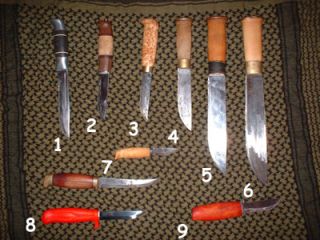
1. Knife from Brusletto
2. Helle Harding
3. Finnish knife (puukko)
4. 6 inch StrÝmeng
5. 8 inch StrÝmeng
6. 9 inch StrÝmeng
7. Hunting knife from KJ. Erikson
8. Mora red handled from KJ.Erikson
9. Modified (handle) Helle Skarping
The small one in the middle, without a number is the Helle Balder.
Small knives
The traditional Norwegian knife (tollekniven) is fairly short, between 3-4 inch blade lengths, there are exceptions though.
The knife has a rat tang, could be all the way trough the handle or partially trough the handle, and usually no guard.
The handle is oval and usually made in the shape similar to that of a troutís body. Handle material is usually wood, but horn, leather, birch bark and metal have also been used.
Many people think a knife without a hand guard is dangerous, and that the handle gets slippery while butchering game.
My experience is that a hand guard mostly get in the way when whittling and butchering game, and that blood from a large animal (moose) quickly gets sticky and donít cause a problem with slippery handles.
When prying one hold the knife high on the handle with the handle end in ones palm. That way there is no chance of cut to the fingers.
After all, this handles have been used long before the Viking age.
There have been some accidents trough the times, but you will solve your fear of these handles by buying a knife with a hand guard.
Mora knives. The old red wood handled Mora is perhaps one of the best knives for the money. It is sharp from the box, easy to sharpen when dull and so cheap that if one break it or loose it you just buy a new one.
I was hunting moose with a cook/butcher and he wouldn`t use anything else than this knife.
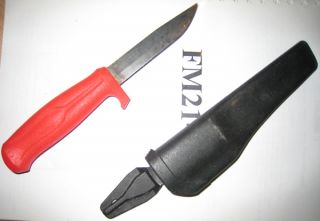 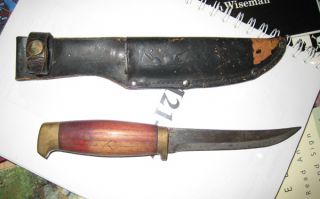
Nowadays one can get an array of different Moras, both stainless and non-stainless.
I prefer the non stainless. These are less brittle and bend rather than brake under stress. And they are easier to sharpen.
One of the stainless ones is however also a good knife. The Mora 2000.
You can also buy the blade blanks and make your own knife with your own touch.
I highly recommend these knives as work knives.
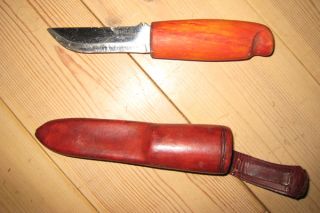
One knife Iíve used much when moose hunting is the Helle Skarping (above). My knife is not original as I have reshaped the awful carrot-shaped handle and made a new sheath for it (The old one was rotten as my father found the knife in the mountains).
The blade is great (laminated steel), holds an edge well, and length and shape of the blade make it good for skinning and whittling.
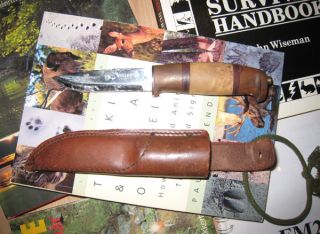
I also own a Helle Harding (above), but I never liked this knife much. It is probably the same steel as the Skarping but it is something with the edge geometry. It is a bad wood carver.
It could also just be me. I`ve always disliked this knife and my feelings for it could be coloured by that.
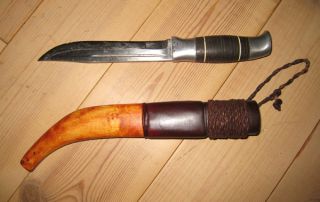
Storhallingen (picture above).
This is the knife Iíve been using most of all recently. The knife was made by Brusletto but now discontinued. The blade (stainless steel) is about 6 inches and I think that makes it a good all round knife. It is long enough for slicing bread and bleeding out big game, but not so big it canít be used for more delicate cutting tasks. The handle is made of aluminium and leather. This knife holds a good edge and is strong enough for batoning wood.
I got the knife from a friend who found it in the woods. Thus the home made sheath.
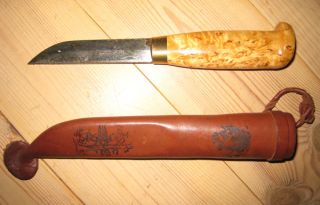
Another knife I recommend is a puukko (knife in Finnish) I bought in Kilpisjarvi some years ago (picture above). The knife is made by Puukko OY in Pello. It has carbon steel blade, 4 inches long. The blade stains/rust easily but is hair popping sharp.
Handle is made of curly birch and the knife comes with a traditional dangler sheath in leather.
An excellent knife to an affordable price.
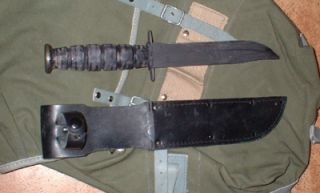
If you want a more military, ďsurvivalknifeĒ look, a USMC fighting knife from either Ontario or Camillus is the answer (above pic).
I have the Ontario version, and even if the knife is crudely made and screams cheap crap it is a though and sharp (after I re-profiled the edge with a file) knife for general use. The blade is 7Ē long, made of 1095 carbon Steel, coated with black epoxy? Handle is made of stacked leather and the knife comes with a black leather sheath.
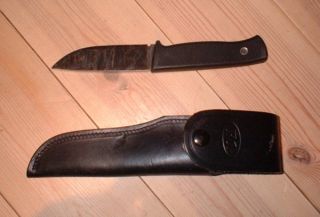
I`ve used the Fallkniven F1 a lot, and this is one of my favourites. The knife is very sturdy, has a full tang and non slip syntetic grip (the grip will get slippery if you got fat from a moose on it, trust me).
The knife has a lanyard hole on the back for those of you who use that, and the tang sticks out a bit in the end, making a surface to use a baton on when needed.
The 4 inch blade (laminated VG-10 steel) is convex ground and holds the edge very well.
The grip is a tad too small for those with big hands but for me it is almost perfect.
My knife came with a black leather sheath with a flap holding the knife in place, but other sheaths are available as well.
The F1 is a poor knife for whittling wood, but not so bad that you don`t can make a decent feather stick with it.
I`ve butchered a bull moose with it and this is tough work. The hide is like sand paper. The knife performs well, but not better than my Helle Skarping. I had to hone it frequently. I didn`t worry about breaking the knife though.
 Using the small knife Using the small knife
Big knives
The bigger knives have traditionally been used (in Norway) by the saami. The big knife was excellent for cutting birch shoots and branches for floor in the lavvu (tent) or goathi (sod house), and the heavier chores of butchering a reindeer.
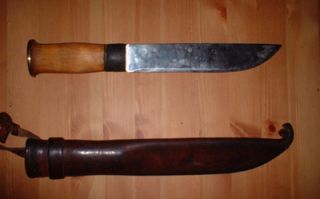
Earlier I only carried a ďbigĒ knife when in the woods, together with a folding knife.
I used a 8 inch sami knife from StrÝmeng in Karasjok, and I still use it sometimes.
I got the knife from my father in 1984 and the knife is just awesome.
I used it to slice bread, chop firewood, gut fish, cut cordage and carving wood. I almost never used the folding knife.
I find the size of the 8 inch to be very versatile.
I`ve tried the 9 inch model, and it chops better but it is not as good for carving and smaller knife duties.
The knife is easy to sharpen and holds the edge well. The weak spot is the sheath. After much use I`ve managed to cut trough the leather on top of the sheath. This is a problem when drawing and sheathing the knife. No matter how careful you are it is bound to happen sooner or later.
If I could only have one knife this would be it.
The saami knives have a fairly thin blade and does not have the same chopping power as other knives of the same size, for instance a BK-9 or a small kukhri, but they are easy to carry. The 8 inch weighs 370 grams and the 9 inch weighs 390 grams.
Homemade saami knife
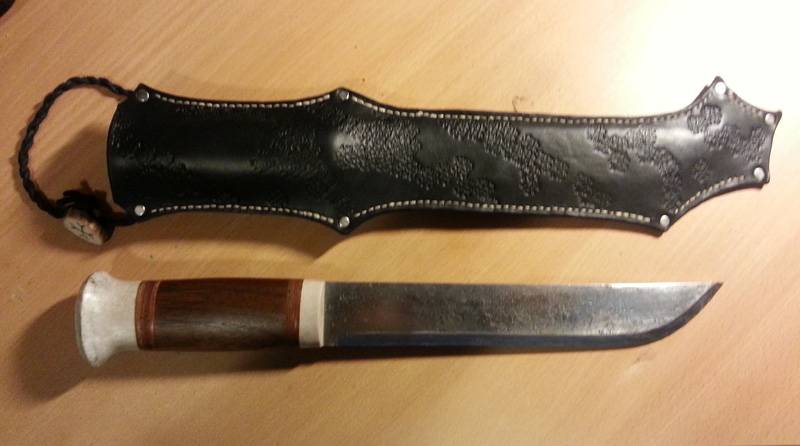
Last year (2012) I made a sami knife with a little thicker blade.
The only drawback of the StrÝmeng knife is that it is a little light for chopping heavier stuff, and I wanted a little heavier knife for chopping, but not one too heavy.
The blade is made by a local blade smith. It is 21.5 centimetres (8.5 inches) long, and 4mm (1/6 inch) thick laminated steel. I opted for a non-polished look, as I prefer it just for the aesthetic value.
The handle is moose antler, walnut with birch bark and leather spacers.
I quite pleased with the knifes performance, but have not used it as much as I hoped.
BK-9
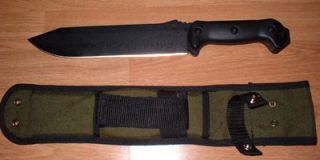
If you are looking for a serious chopper to a fair price I recommend the BK-9 from Becker knife and tool company.
It is an awsome chopper and have a 9 inch blade with a razor sharp edge.
This knife replaces the small axe you might consider taking into the woods.
The sheath is made of nylon lined with kydex and have a big pocket suitable for a hone, small pocket knife and a firesteel.
The whole thing weighs 690 grams. The same as a small hachet.
The handle is however a tad too thick (at least for my hand). I unscrewed the handle (an easy task) and used sandpaper to take some millimeters of the handle plates. Now it`s all right.
A lot of knife for the money (if you don`t buy it in Norway. Awesome prices on these knives in Norway. Use the web and buy it from the US).
Many survival manuals (mostly british) mention the Kukhri, a traditional knife of Nepal. As I own two of these I will describe one of them.
The BAS (British Army Service) is a powerful chopper. It is about 15 inch long and the blade is about 6mm thick at the spine. The whole knife weigh 860 grams.
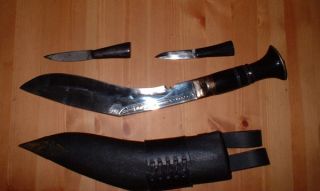
Two other "tools" are placed in it`s scabbard. A small knife and a combined firesteel and sharpening steel.
The knife chops like an axe and you can also use it as an drawknife. But in my opinion the axe is as good a chopper and the weight is about the same and I rather take the axe. This is one of the big knives one can`t do small knives chores with. If you don`t replace the little knife with something one could use.
The leaf hook or billhook (picture below) is another tool that is great for the northern forests. It main purpose was gathering feed for the livestock (bundles of leaf), but it can be used amost as any other big knives. The billhook is a great chopper. The billhook has no sharp point so it is not something you prepare game with, thus making it less versatile.
I`ve ground the hook away on my billhook. The reason for that was that it was round and unsharpened. Now I can use it for scoring bark, wood and even gut fish with it.
Most billhook come without a sheat and if you plan to use it in the woods you better make one for it.
My old method as a kid was to wrap the blade in a newspaper and secure it with a rubber band. That worked good as I stored it in my rucksack anyway.
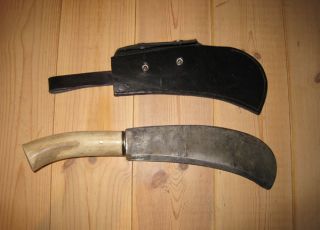
Below are some pictures from a recent test of the leaf hook. The leaf hook will outchop the StrÝmeng sami knife anytime. The first picture is of a 3 cm thick pine branch. A light chop almost went right trough.
The other is of a 10 cm thick pine branch (same downed tree). I chopped the branch off in no time and with very little effort.
If you want a cheap, good chopper you should consider the bill hook.
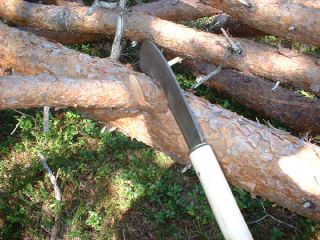 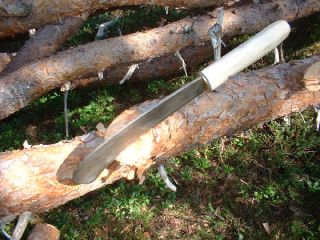
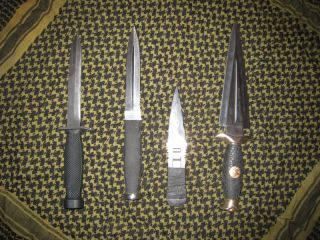
Knives I seldom use (above).
Knives with broad or upswept blades (typical skinners), serrated edge or double edge donít see much use by me. I own some and I keep them as part of my collection.
I think they are too awkward to use to carry along in the woods unless I have a specialised task for them. This also go for most "sharpened prybars" and most knife with tachtical in their name.
 Other types of knives Other types of knives
Axe
An axe is not a necessity in the woods but if you are going to do some serious chopping it is a nice item to have along (In older times they regarded the axe very important. If your canoe capsize let the gun go but save the axe, is an old saying).
Best of all are a fairly large axe, like the Scandinavian forest axe type. There are many companies that make such axes, Granfors Bruk of Sweden are one of the more popular brands.
I have an old forest axe of unknown origin that I got from my grandfather, and the axe works like a charm (picture below).
Just be sure that the axe is as sharp as your knife.
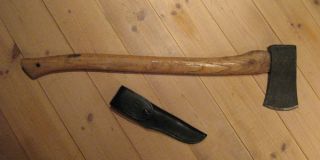
Also check the grain of the handle. The grain should run parrallel to the axe head to minimise the chanse of breaking it.
It is tiresome (and a bit dangerous) to lug about with an axe in your hand. Make an edge protection for it and strap it to your rucksack.
For those who don`t want to carry the weight of a large axe a smaller axe or tomahawk may be the answer.
I have one from ōyo (bottom in picture below left) wich works well enough. It is a small axe, about 600 grams, and holds a decent edge (there was sadly no egde on it when I bought it). It comes with an edge protection of false leather.
The axe is light and doesn`t take up much room in your ruck, but it is heavy enough for both cutting and splitting firewood for the day/weekend trips.
On the picture below right are two small axes with their edge protector. The left one is an axe from Hults Bruk and the right one is a small hunters axe from Wetterlings. These axes are very good and I recommend them both.
The Wetterlings is actually the best hatchet I`ve handled. It is fairly heavy and has a very sharp edge. It is a charm to chop firewood with it (I have later replaced the haft with a longer and thinner one. It is now more like a scandinavian forest axe).
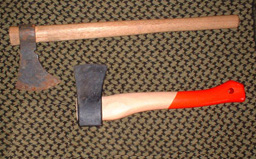 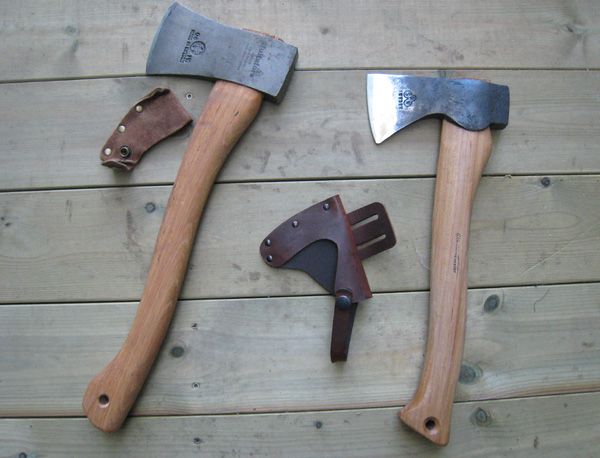
I also have a tomahawk (made in India, below) wich I`ve "customised". It has a 19 inch hickory handle and weighs about 800 grams. I`ve made a "mountain man sheath" for it and it has become a nice item for the woods. It has not the best temper but it is easy to sharpen or fix if I should wack it in a stone by accident. Besides one can remove the head from the handle and use it like an ulu.
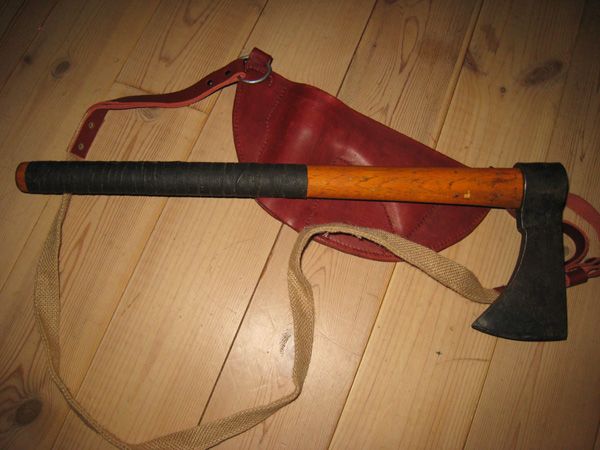
The tomahawk is no match for the hatchets though. Even the lousiest hatchet I own will out chop this hawk anytime, but it has a certain old fashioned charm that I really like.
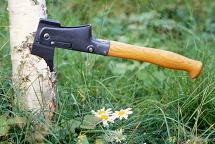
Norseaxe made a nice axe in the 80`s. The head coud be locked in 3 positions. The first position with the edge down, the transport position. The other as an ordinary axe and in the third position it looked like a debarking axe. I don`t know of they are available today.
Using the axe
Be careful when using an axe. It is easy to cut onself in the legs when using one. I find the larger forest axes to be the safest to use. They tend to hit ground before they hit you.
Look out for overhanging branches and be sure you have plenty of space to yield the axe.
That said I have never cut myself with an axe.
Common sence is the key.
Steel and cold weather
Steel becomes brittle in strong cold. If the temperature is -20 degrees Celsius or lower, and you chop hard wood you may brake off pieces from the edge. When using an axe or knife in cold weather warm the blade by the fire before use.
I have actually broken a piece of the edge from a cheap bowie knife in less then -20 degrees. Take care of your tools in cold weather.
Saw
An old bow saw is of course the best saw for cutting firewood, but it is not so convenient for hiking.
Smaller collapsible saws are a better choice.
The Sandvik Laplander is an excellent choice for day trips and hunting. It is fairly cheap and very light. It is easy to use and has a sharp blade which is replaceable. I`ve had this saw for about 10 years and used it both for wood and butchering (sawing bone). The blade still doesn`t need to be replaced.
The saw works on both push and draw.
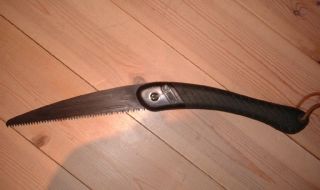 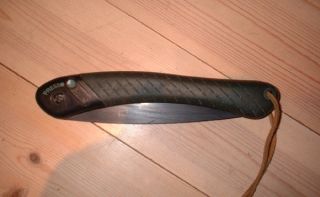
Lately I have bought a triangular folding saw, made in sweden, with 3 saw blades stored in the saw frame. One blade is for wood, one for meat and the last one for metal. The blades are 20 inches long and easy to replace if broken or dull.
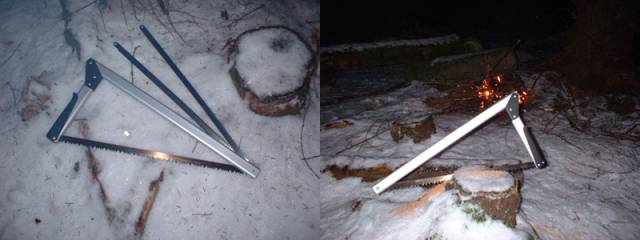
This is a much better saw to use on heavy logs than the Laplander. The down side is that it rattles a bit because of the extra blades in the frame, and it is a little more space consuming.
Another saw I have is called Jaws pruning saw. It cuts only on the draw motion. The saw actually outcuts the Laplander, but the saw seems more flimsy. Besides, the pin holding the blade lock fell out and the saw was useless (picture below right). The pin is now replaced and peened on both sides.
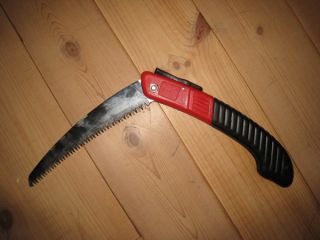 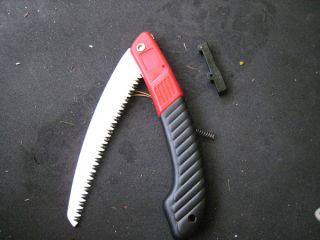
You could also make an old fashioned bow saw if you have a saw blade with you. Either curled together in your pack or taped on the inside of your belt.
Make a handle for it from a bent 3-4 cm thick branch with suitable lenght. Make a cut at each end of the branch.
Attatch two bolts or nails to the small holes on each end of the saw blade. Press or gently hammer the saw blade down in the end cut of the branch, bend the branch and hammer the other end of the saw blade down in the branch other end cut. You now have a bow saw. If you don`t my explanation sucks.
|